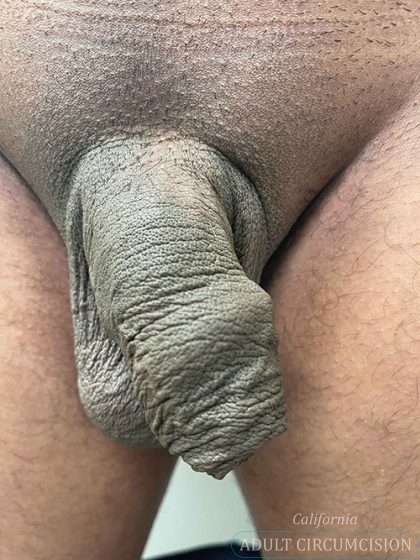Adult circumcision is a relatively uncommon procedure since so many males are circumcised as newborns. Among American adult men, circumcision is most commonly sought out for health reasons, but many others choose to undergo the procedure for aesthetic enhancement. Regardless of the reasoning, adult circumcision rates average at almost 100 per 100,000 men in the United States. Lower rates of this procedure can be attributed to the prevalence of this procedure- about 80% of males between the ages of 14 and 59 are already circumcised. (1)
If you feel intimidated by the idea of adult circumcision, Dr. Mo Bidair can walk you through the necessary steps to help you feel at ease with your decision. As a board-certified urologist with over 30 years of experience with this intricate procedure, you can rest assured that essential anatomy and sensitivity stay intact post-surgery. If you have been struggling with issues related to the appearance, tightness, or discomfort of your foreskin, consider scheduling a consultation with Dr. Bidair at his office near San Diego, CA by calling (619) 486-5005. You can also reach out using his contact form, and a member of his staff will assist you in booking your appointment.
Contents
Before and After Photos
Common Reasons for Adult Circumcision
Of the men involved in a nationwide study, approximately 52.5% of participants chose circumcision as a means to resolve a painful condition called phimosis. This condition is characterized by a tightening of the foreskin and the inability to pull it back. Men with phimosis can have difficulty with sexual activity, urinating, and other uncomfortable symptoms like soreness and irritation.
Technically, every male is born with the condition, but typically, after 2 years of age, the foreskin properly separates from the glans- the head of the penis. Research estimates that in men over 18, the average rate of incidence for the condition is 3.4%. (2) For the most part, doctors recommend waiting to see if the condition clears on its own. If not, steroid creams can relieve symptoms. For grown men who have dealt with the condition their entire lives, surgery is likely the only permanent solution. Only surgery can completely prevent phimosis from worsening into a more serious issue called paraphimosis that requires immediate medical attention. With paraphimosis, the foreskin gets trapped behind the head of the penis and can cause serious pain, swelling, and even loss of blood circulation.
Religious and/or aesthetic reasons were indicated in the nationwide study as the second most popular reasons for adult circumcision, making up 28.7% of the participants. This demonstrates that even with the many health benefits of circumcision, many men still value it as a means to cosmetically enhance this intimate part of their body or to accurately reflect their religious beliefs.
The third most common reason was for the treatment of balanitis or balanoposthitis with or without the presence of phimosis, with about 13.2% of the men in the study showing symptoms of these penile issues. Balanitis causes mild to severe inflammation in the head of the penis, causing redness or other discoloration, swelling, painful urination, and itchiness. Individuals with balanitis have a 3.8-fold increased risk of developing penile cancer. When it occurs alongside phimosis, it can be incredibly difficult to treat, so many men turn to surgery. When there is noticeable inflammation in both the foreskin and the glans, it becomes a form of cellulitis, a bacterial skin infection.
Benefits of Circumcision
Dr. Bidair understands that surgery in such a sensitive area is a big decision. He ensures that every one of his patients receives accurate information regarding their health and sexual functioning. If you think this low-risk procedure may be right for you, consider the benefits:
- Circumcision lowers your risk of developing balanitis by 68%. (3)
- You can completely avoid developing balanoposthitis and the health risks associated with it.
- You can reduce your risk of bacterial and fungal infections that commonly occur just under the foreskin.
- Men without foreskins have a lower risk of contracting STIs. (4)
- The procedure won’t impede your sexual performance; more exposure of the glans may contribute to greater sexual enjoyment.
- Circumcised men have lower rates of penile cancer. (5)
- You can decrease your risk of pearly penile papules (PPPs), tiny, harmless growths that can look like genital warts under the head of the penis. If you have been properly diagnosed with PPPs and STIs have been ruled out, Dr. Bidair can safely remove them using just local anesthesia and a precise device that vaporizes the growths without harming the surrounding tissues.
- With circumcision, you will greatly lower your risk of developing UTIs due to less bacteria around the glans.
- Although it is a highly personal decision, it is considered the norm in the United States, and the majority of males are circumcised. (1) You may feel more comfortable in intimate situations and feel confident about the aesthetics of your penis.
Personal Consultation
When you schedule your consultation with board-certified urologist, Dr. Bidair, you can expect to be met with professionalism and sensitivity regarding your unique case. He will walk through the typical preparation and recovery steps as well as your circumcision options. While many surgeons perform the procedure in just a few minutes, Dr. Bidair takes the time to utilize only the most intricate techniques that will produce incredible results that will flatter your anatomy as a whole. If you feel ready to talk about your interest in circumcision, or simply ask questions, you can reach Dr. Bidair at his office in San Diego by dialing (619) 486-5005 or using his contact page to request your consultation today. Feel free to read through Dr. Bidair’s blog to get more information on male reproductive health and more details on circumcision.
What Are My Procedure Options?
There is no one-size-fits-all procedure for men seeking circumcision. Dr. Bidair is skilled in several techniques that will give you the freedom to choose your cosmetic outcome that resolves issues caused by the foreskin. These include:
High and Loose
For a high and loose circumcision, Dr. Bidair will make a circumferential incision around the shaft, further away from the head. He will preserve more skin to create a looser fit, allowing for more skin movement during sexual activity.
High and Tight
In high and tight techniques, Dr. Bidair will make the incision higher up on the shaft, removing more skin so that the end result feels more secure, supportive, and preserves the contours of the penis.
Low and Loose
A low and loose circumcision involves a circumferential incision much closer to the base of the glans, allowing for greater movement of the foreskin with an exposed head.
Low and Tight
Dr. Bidair performs low and tight procedures utilizing an incision just under the glans, but more skin is removed to provide a tighter appearance and feel.
Dr. Bidair performs all circumcisions using local anesthesia, so you won’t feel any discomfort for the entire duration of the procedure, which takes about 1 and a half hours.
Recovering from Circumcision
Following your circumcision, it’s vital that you follow all recovery steps outlined by Dr. Bidair. During the first few days, you may have some discomfort and tenderness around the head of your penis and from the local anesthesia injections. Dr. Bidair will prescribe medications to keep you completely comfortable for the duration of the healing process. The area will remain completely bandaged for the first 24 to 48 hours post-procedure. Once these are removed, the penis will still need more time to heal. Suture removal is not necessary; Dr. Bidair uses dissolvable sutures, so you won’t have to return to the office for another appointment.
Once your bandages come off, you will be able to gently wash the area, staying mindful of avoiding harsh, fragranced soaps and exfoliants. Some men are able to resume their normal activities right away, while others may need 1 week of downtime to rest. After the first week, you may be able to participate in moderately strenuous activities. A medical professional from Dr. Bidair’s staff will carefully monitor your progress and provide you with guidance.
Although having erections during your recovery is normal, Dr. Bidair advises his patients to avoid sexual activity for 2 to 4 weeks, depending on your individual rate of healing. Once you are able to resume, you should use a condom to prevent further irritation or damage. Within the next 2 to 3 months, the scar line around your penis will gradually fade, and you will get to enjoy the look and feel of your final results.
Cost of Adult Circumcision in San Diego
The cost of your circumcision will depend on your unique anatomy, age, technique used and other health factors that Dr. Bidair will take into consideration. Any appointments following the procedure or during recovery will also contribute. At the time of your consultation, Dr. Bidair will be sure to properly inform you of what you need to know for your procedure, answer any remaining questions, and provide you with a total cost estimate. To get more information, or to schedule an appointment today, call (619) 486-5005 to reach his office in San Diego. Alternatively, you can inquire using our online form, and we will get back to you as soon as possible.
References
- Nabavizadeh B, Li KD, Hakam N, Shaw NM, Leapman MS, Breyer BN. Incidence of circumcision among insured adults in the United States. PLoS ONE. 2022;17(10):e0275207. doi:https://doi.org/10.1371/journal.pone.0275207
- Morris BJ, Matthews JG, Krieger JN. Prevalence of Phimosis in Males of All Ages: Systematic Review. Urology. 2020;135:124-132. doi:https://doi.org/10.1016/j.urology.2019.10.003
- Wray AA, Velasquez J, Khetarpal S. Balanitis. PubMed. Published 2021. https://www.ncbi.nlm.nih.gov/books/NBK537143/#:~:text=Balanitis%20is%20an%20inflammation%20of%20the%20glans%20penis%20
- Marfatia Y, Mehta K, Jain A, Shah D, Baxi D. Male circumcision and Sexually transmitted Infections – An update. Indian Journal of Sexually Transmitted Diseases and AIDS. 2021;42(1):1. doi:https://doi.org/10.4103/ijstd.ijstd_20_21
- Ornellas AA, Ornellas P. Should routine neonatal circumcision be a police to prevent penile cancer? | Opinion: Yes. International braz j urol. 2017;43(1):7-9. doi:https://doi.org/10.1590/s1677-5538.ibju.2017.01.03











